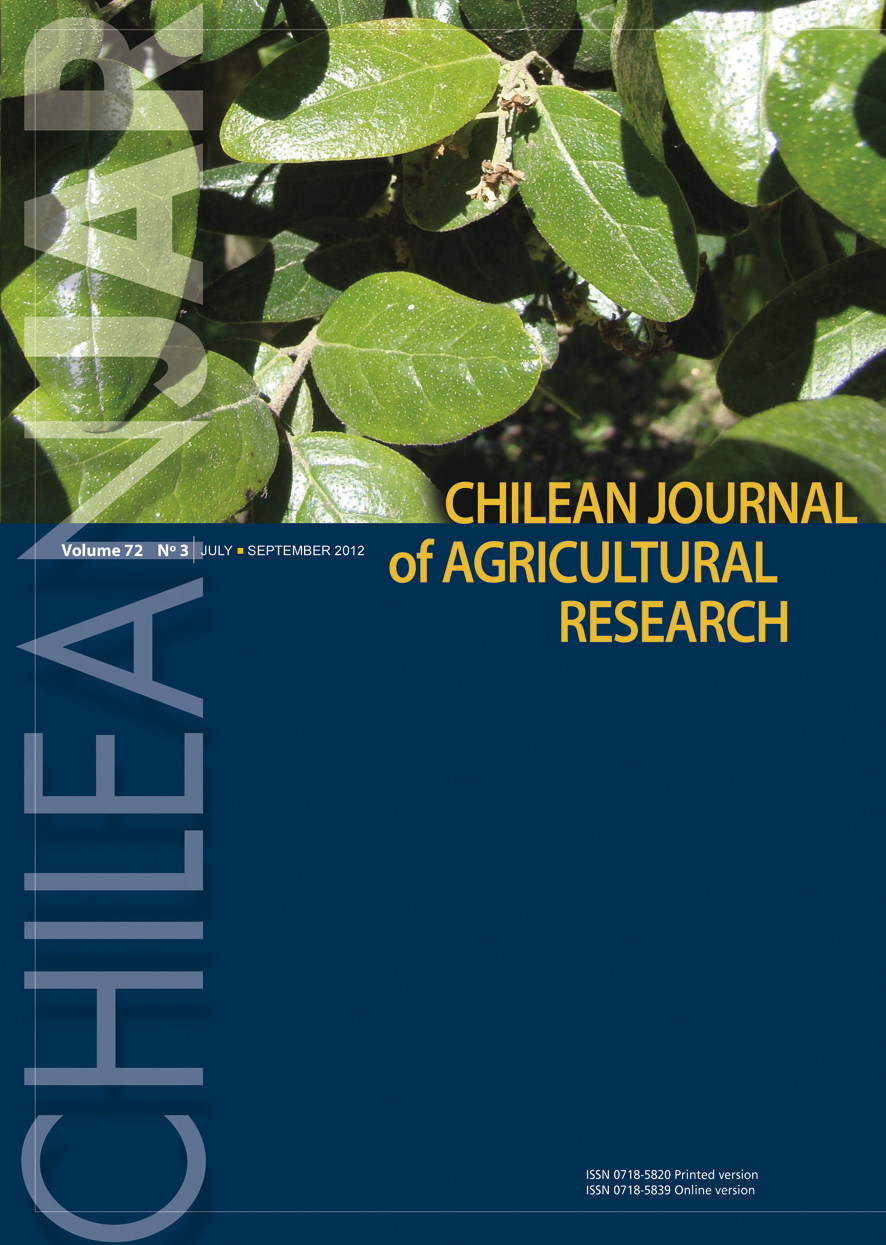
|
Chilean Journal of Agricultural Research
Instituto de Investigaciones Agropecuarias, INIA
ISSN: 0718-5820
EISSN: 0718-5820
Vol. 70, No. 3, 2010, pp. 357-364
|
 Bioline Code: cj10039
Bioline Code: cj10039
Full paper language: English
Document type: Research Article
Document available free of charge
|
|
|
Chilean Journal of Agricultural Research, Vol. 70, No. 3, 2010, pp. 357-364
| es |
Herencia del peso de grano en Lathyrus sativus L. de semilla grande
Ulloa, Pilar & Mera, Mario
Resumen
.Los granos de chícharo (Lathyrus sativus L.) de mayor tamaño son preferidos en mercados occidentales, por tanto, el peso medio de grano (PMG) es un carácter comercialmente relevante. Extender el conocimiento sobre su modo de herencia sería útil para programas de mejoramiento y fue el objetivo de este trabajo. El chícharo presenta amplio rango para PMG, partiendo desde 30 mg. Tres líneas (LS-97, LS-8, LS- 2026) consideradas de semilla grande, pero con PMG significativamente diferentes (179, 360 y 470 mg, respectivamente) se cruzaron en un dialelo completo. Parte de la semilla F1 se sembró y otra se conservó. Flores en plantas F1 de cada cruza se retrocruzaron con sus respectivos progenitores y el resto produjo semilla F2. En 2006 se sembraron progenitores, poblaciones F1 y F2, y retrocruzamientos. Se midió PMG de plantas individuales de cada población, cultivadas en secano. Las medias de recíprocos de cruzas LS-8 × LS-2026 y LS-8 × LS-97 no fueron significativamente diferentes, y en ambas los datos se reunieron, asumiéndose herencia del PMG controlada sólo por genes nucleares. Sin embargo, la población F2 de la cruza LS-97 × LS-2026 y su recíproco presentaron medias diferentes, sugiriendo presencia de herencia citoplasmática. Por ello, los datos de estos recíprocos se mantuvieron separados para calcular heredabilidad. Las heredabilidades en sentido amplio de PMG para las cruzas LS-97 × LS-8 y LS-8 LS-2026 fueron estimadas en 0,50 y 0,32 respectivamente, y en 0,23 y 0,24 para la cruza LS-97 × LS-2026 y su recíproco, respectivamente. Las heredabilidades en sentido restringido fueron 0,42 y 0,28, y 0,15 y 0,22, respectivamente. La varianza de las líneas parentales de mayor PMG, particularmente LS-2026, fue mucho mayor, incrementando la estimación de la varianza ambiental en las cruzas donde participaron. En todas las cruzas los efectos genéticos predominantes fueron aditivos, prediciendo buena respuesta a la selección durante generaciones segregantes tempranas. Por tanto, los prospectos para aumentar PMG en chícharos de grano grande son auspiciosos.
Palabras-clave
chícharo, almorta, heredabilidad, leguminosas de grano.
|
| |
| en |
Inheritance of seed weight in large-seed grass Pea Lathyrus sativus L.
Ulloa, Pilar & Mera, Mario
Abstract
Mean seed weight (MSW) is a relevant trait in grass pea (Lathyrus sativus L.) commercialization because large grains are preferred in Western markets. Extending the knowledge on its mode of inheritance among large-seeded types would be useful in breeding programs, and therefore it was the objective of this work. A broad range of MSW is found in grass pea, starting at about 30 mg. Three lines (LS-97, LS-8, and LS-2026) within the large-seeded group but with significantly different MSW (179, 360 and 470 mg, respectively), were crossed in a complete diallel. Part of the F 1 seed was sown and the remainder was stored. F 1 plants from each cross were allowed to produce F 2 seed and some were backcrossed to their respective parents. Parents, F 1 , F 2 , and backcross populations were grown in the field in 2006. MSW was obtained from single plants in each population. No difference was observed between reciprocals of crosses LS-97 × LS-8 and LS-8 × LS-2026; therefore, data from reciprocals were combined, assuming nuclear inheritance. However, F 2 segregating population from cross LS-97 × LS-2026 and its reciprocal gave significantly different means, suggesting cytoplasmic inheritance. Consequently, F 2 and backcross data were handled separately to calculate heritability. Parent lines with high MSW, particularly LS-2026, had greater variances, raising the estimate of environmental variance. Broad sense heritability estimates for MSW were 0.50 and 0.32 for crosses LS-97 × LS-8 and LS-8 × LS-2026, respectively, and 0.23 and 0.24, for cross LS-97 × LS-2026 and its reciprocal, respectively. Narrow sense heritabilities were 0.42 and 0.28, and 0.15 and 0.22, respectively. In all crosses, the genetic effects were predominantly additive, predicting a good response to selection for increased MSW in early segregating generations. Thus, the prospects to improve MSW in large-seeded grass peas are auspicious.
Keywords
grass pea, heritability, cool-season grain legumes
|
| |
© Copyright 2010 Chilean Journal of Agricultural Research.
Alternative site location: http://www.inia.cl
|
|
